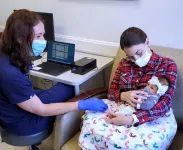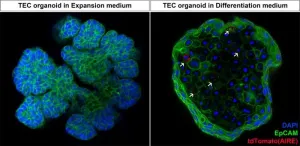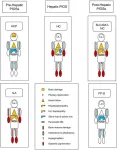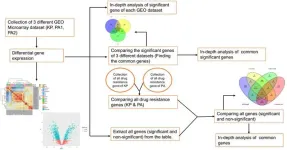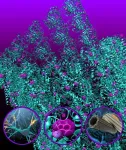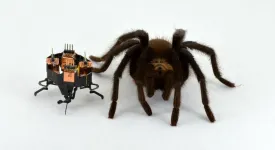(Press-News.org) A modified pacifier and AI algorithms to analyze the data it produces could determine if newborns are learning the proper mechanics of nursing, a recent study shows.
Specifically, the researchers from the University of California San Diego measured if babies are generating enough suckling strength to breastfeed and whether they are suckling in a regular pattern based on eight independent parameters.
The results, published in the April 18 online edition of IEEE Journal of Translational Engineering in Health and Medicine, give researchers objective data that shows standard assessments can be improved and could potentially prevent surgical interventions.
Currently, to determine if an infant is feeding properly, clinicians rely on two measures. One is objective: is the baby gaining enough weight? The other is more subjective: clinicians put a finger in the baby’s mouth and evaluate how well the baby is sucking on that finger.
“The method we developed with our clinical partners replaces this subjective assessment with objective data,” said James Friend, a professor in the Department of Mechanical and Aerospace Engineering and the Department of Surgery at UC San Diego and one of the paper’s senior authors.
The testing method has two components. One is a device made up of a simple pacifier, connected to a 36-inch-long tube connected in turn to a vacuum sensor and a chip that collects the data from the sensor. The device can connect to any laptop.
“We wanted to keep the technology as simple as possible with off-the-shelf, cost-effective components to facilitate adoption in the clinic,” said Friend, who is a faculty member at the UC San Diego Jacobs School of Engineering.
The second component is software that both displays the data and uses machine learning algorithms to identify abnormalities and outliers. The software records data as an infant sucks on the pacifier and compares that data with information from other infants. Two different machine learning algorithms analyze the data and flag abnormal patterns if they are present.
Prior studies have shown that non-nutritive suckling on a pacifier produces data that can be used to evaluate breastfeeding.
“It’s reassuring for me to rely on scientific data to back up my assessments,” said co-senior author of the study, Erin Walsh, a speech-language pathologist and lactation consultant at UC San Diego Health. “We hope our findings help support parents struggling to breastfeed and improve long-term health outcomes.”
The study’s findings mostly validated clinician conclusions. But the study also showed that subjective evaluation of infants’ suckling ability by a clinician inserting their fingertip into the infants’ mouth, which is currently standard practice, could be improved by data the device generates.
“Early detection of breastfeeding difficulties within the first month is critical, as it coincides with the important phase of milk establishment and susceptibility to breast injury,” said Phuong Truong, the paper’s first author and a Ph.D. student in Friend’s lab.
Although mothers can receive medical assistance, the absence of precise measurement tools means that identifying underlying issues can take longer, potentially contributing to a decline in breastfeeding rates, she said. “Our measurement system aims to offer rapid and precise data on an infant's suckling ability early on, empowering clinicians to address root causes quickly and potentially mitigate breastfeeding attrition,” Truong said.
Is tongue-tie surgery needed?
An estimated 7% of babies are diagnosed with a condition called tongue-tie, in which the connection between the tongue and the floor of the mouth is too strong and limits tongue movement. The condition presents challenges with breastfeeding and often requires surgery, known as a frenotomy, where the connective tissue between the tongue and the floor of the mouth are cut.
Data from the device showed there was not a change pre and post-surgery for half of the infants examined who had undergone a frenotomy. The other half, whose data patterns were abnormal, and whom the algorithms identified as needing a frenotomy, did benefit from the operation with much improved suckling behavior after the surgery.
These results suggest that, in some cases, surgical interventions could potentially be prevented.
Data from the device also flagged abnormal nursing behavior in five babies, which had not been found during a clinical exam.
These findings are important because frenotomies have had a tenfold increase in less than a decade. “Our data show that frenotomies are not a blanket solution for breastfeeding difficulties,” Walsh added.
How the study was conducted
The proof of concept study was approved by UC San Diego’s Internal Review Board. Parents of healthy full-term infants under 30 days old were recruited from the UC San Diego Center for Voice and Swallowing, UC San Diego Health La Jolla Pediatrics, and the UC San Diego Jacobs Medical Center.
In all, the 91 participants in the proof of concept study were recruited during routine postpartum care with their general pediatrician at UC San Diego Health or while consulting with feeding specialists at their respective locations. Infant inclusion criteria included full-term healthy infants establishing breastfeeding and without significant birth or postpartum complications.
Clinicians were blinded to device data in this study and performed evaluations solely based on standard practice. After clinical assessments, parents were provided the opportunity to introduce the modified pacifier for a 60 second measurement of their infant’s intraoral suckling vacuum.
Next steps
Next steps include conducting a clinical trial outside of UC San Diego Health with the ultimate goal of making both the device and algorithm widely available in pediatric practices, where they could be used during an infant's first visit.
Friend and Walsh are in the process of starting a company to license the technology from UC San Diego and bring it to the clinic.
The study was funded in part with the Galvanizing Engineering in Medicine initiative at UC San Diego, National Institutes of Health and the Willia H. and Mattie Wattis Harris Foundation and the UC San Diego Krupp Center for Integrative Research.
Application of Statistical Analysis and Machine Learning to Identify Infants’ Abnormal Suckling Behavior
Phuong Truong and James Friend, Medically Advanced Devices Laboratory, Department of Mechanical and Aerospace Engineering, Jacobs School of Engineering and Department of Surgery, School of Medicine, University of California at San Diego
Erin Walsh, Center for Voice and Swallowing, Department of Otolaryngology, School of Medicine, University of California at San Diego
Vanessa P. Scott and Michelle Leff, Department of Pediatrics, School of Medicine, University of California at San Diego, San Diego
Alice Chen, UC San Diego School of Medicine, UC San Diego Health, Department of Family Medicine
END
AI algorithms can determine how well newborns nurse, study shows
Data collected in a proof-of-concept study can help determine if a surgical intervention is necessary and help improve overall outcomes for baby and parent
2024-04-29
ELSE PRESS RELEASES FROM THIS DATE:
Scientists develop new organoid model to study thymus function
2024-04-29
Researchers from the Organoid group have developed a new organoid model that can be used to study the thymus. The organoids, derived from mouse thymus tissue, specifically model thymic epithelial cells (TECs). These cells are responsible for training the T cells of the immune system to properly respond to pathogens. It is the first laboratory model that enables long-term culture of TECs, which presents new opportunities to study their function. Ultimately, this could also bring new insights into the treatment ...
A revised classification of primary iron overload syndromes
2024-04-29
Background and Aims
The clinical introduction of hepcidin25 (Hep25) has led to a more detailed understanding of its relationship with ferroportin (FP) and divalent metal transporter1 in primary iron overload syndromes (PIOSs). In 2012, we proposed a classification of PIOSs based on the Hep25/FP system, which consists of prehepatic aceruloplasminemia, hepatic hemochromatosis (HC), and posthepatic FP disease (FP-D). However, in consideration of accumulated evidence on PIOSs, we aimed to renew the classification.
Methods
We ...
Expanding health equity by including nursing home residents in clinical trials
2024-04-29
INDIANAPOLIS – Clinical trials are constantly being designed and study participants enrolled to determine if medical treatments and therapies are safe and effective. Much has been written about the importance of including diverse populations in these trials.
However, the nearly 1.4 million individuals who live in the 15,600 nursing homes across the U.S. have been largely left out of clinical trials, despite the prevalence of such common conditions as hypertension, depression, diabetes and Alzheimer’s disease in this population.
A commentary by faculty of Regenstrief Institute, Indiana University, UCLA ...
Identification and exploration of transcripts involved in antibiotic resistance mechanism of two critical superbugs
2024-04-29
Background and objectives
Infectious diseases caused by pathogenic strains of bacteria are a global cause of morbidity and mortality. Hospital-acquired infections caused by Klebsiella pneumonia and Pseudomonas aeruginosa were found vulnerable during the COVID-19 pandemic. They are also responsible for the onset of certain life-threatening infectious diseases such as cystic fibrosis, endocarditis, bacteremia, and sepsis. Looking into the importance of these two superbugs there is a strong need for extensive comparative differential gene expression analysis ...
Quantum fiber optics in the brain enhance processing, may protect against degenerative diseases
2024-04-29
WASHINGTON, DC – (April 26, 2024) The effects of quantum mechanics—the laws of physics that apply at exceedingly small scales—are extremely sensitive to disturbances. This is why quantum computers must be held at temperatures colder than outer space, and only very, very small objects, such as atoms and molecules, generally display quantum properties. By quantum standards, biological systems are quite hostile environments: they’re warm and chaotic, and even their fundamental components—such as cells—are considered very large.
But ...
Icahn School of Medicine at Mount Sinai names Miriam Merad, MD, PhD, as Dean for Translational Research and Therapeutic Innovation
2024-04-29
New York, NY [April 29, 2024]—Miriam Merad, MD, PhD, a world-renowned immunologist, has been appointed Dean for Translational Research and Therapeutic Innovation of the Icahn School of Medicine at Mount Sinai. The appointment reaffirms Icahn Mount Sinai’s commitment to pioneering medical progress and catalyzing the rapid advancement of research innovation.
Dr. Merad, the Mount Sinai Professor in Cancer Immunology, will also continue to serve as the founding Chair of the Department of Immunology and Immunotherapy, Director of the Marc and Jennifer Lipschultz Precision Immunology Institute, and Director ...
Details of hurricane Ian’s aftermath captured with new remote sensing method
2024-04-29
Category 4 Hurricane Ian made landfall in Florida’s Lee County on Sept. 28, 2022, battering the region with wind speeds of 155 miles per hour and storm surge up to 13 feet – the highest storm surge documented in Southwest Florida in the past 150 years.
In the aftermath of a disaster, rapidly assessing damage is critical for rescue, recovery and emergency planning. Damage assessments are typically conducted through field reconnaissance deployments, which can be labor-intensive, costly and risky. Moreover, field-based emergency response ...
Robots can’t outrun animals. A new study explores why
2024-04-29
The question may be the 21st century’s version of the fable of the tortoise and the hare: Who would win in a foot race between a robot and an animal?
In a new perspective article, a team of engineers from the United States and Canada, including University of Colorado Boulder roboticist Kaushik Jayaram, set out to answer that riddle. The group analyzed data from dozens of studies and came to a resounding “no.” In almost all cases, biological organisms, such as cheetahs, cockroaches and even humans, seem to be able to outrun their robot counterparts.
The researchers, led by Samuel Burden at the University of Washington and ...
The Human Immunome Project unveils scientific plan to decode and model the immune system
2024-04-29
NEW YORK, April 29, 2024 – The Human Immunome Project (HIP), a global nonprofit scientific initiative, released its Scientific Plan today, on World Immunology Day, the organization announced. The plan provides a detailed roadmap of how the Human Immunome Project and its network of global study sites will generate the world’s largest and most diverse immunological dataset and use these data to power publicly available AI models of the immune system.
“The immune system is the epicenter of human health, and our newly released ...
New research funding awarded to assess the role of race in predicting heart disease
2024-04-29
Highlights:
The American Heart Association awarded four new scientific research grants to evaluate the role of race in measuring heart disease risk.
The funded studies are focused on multi-ethnic groups and studying how race, considered a social rather than biological construct, affects health risk prediction when it is incorporated as a variable in algorithms.
This research is funded by a grant from the Doris Duke Foundation to study the complex issue of how race and ethnicity, when factored into cardiovascular clinical care algorithms ...
LAST 30 PRESS RELEASES:
Bluey’s dad offered professorial chair in archaeology at Griffith University
Beyond small data limitations: Transfer learning-enabled framework for predicting mechanical properties of aluminum matrix composites
Unveiling non-thermal catalytic origin of direct current-promoted catalysis for energy-efficient transformation of greenhouse gases to valuable chemicals
Chronic breathlessness emerging as a hidden strain on hospitals
Paleontologists find first fossil bee nests made inside fossil bones
These fossils were the perfect home for ancient baby bees
Not everyone reads the room the same. A new study examines why.
New research identifies linked energy, immune and vascular changes in ME/CFS
Concurrent frailty + depression likely boost dementia risk in older people
Living in substandard housing linked to kids’ missed schooling and poor grades
Little awareness of medical + psychological complexities of steroid cream withdrawal
Eight in 10 trusts caring for emergency department patients in corridors, finds BMJ investigation
NASA’s Webb telescope finds bizarre atmosphere on a lemon-shaped exoplanet
The gut bacteria that put the brakes on weight gain in mice
Exploring how patients feel about AI transcription
Category ‘6’ tropical cyclone hot spots are growing
Video: Drivers struggle to multitask when using dashboard touch screens, study finds
SLU research shows surge in alcohol-related liver disease driving ‘deaths of despair’
Rising heat reshapes how microbes break down microplastics, new review finds
Roots reveal a hidden carbon pathway in maize plants
Membrane magic: FAMU-FSU researchers repurpose fuel cells membranes for new applications
UN Member States pledge to increase access to diagnosis and inhaled medicines for the 480 million people living with COPD
Combination therapy shows potential to treat pediatric brain cancer ATRT
Study links seabird nesting to shark turf wars in Hawai‘i
Legal sports betting linked to sharp increases in violent crime, study finds
Breakthrough AI from NYUAD speeds up discovery of life-supporting microbes
New Eva Mayr-Stihl Foundation funding initiative boosts research at University of Freiburg on adaptation of forests to global change
The perfect plastic? Plant-based, fully saltwater degradable, zero microplastics
Bias in data may be blocking AI’s potential to combat antibiotic resistance
Article-level metrics would provide more recognition to most researchers than journal-level metrics
[Press-News.org] AI algorithms can determine how well newborns nurse, study showsData collected in a proof-of-concept study can help determine if a surgical intervention is necessary and help improve overall outcomes for baby and parent
